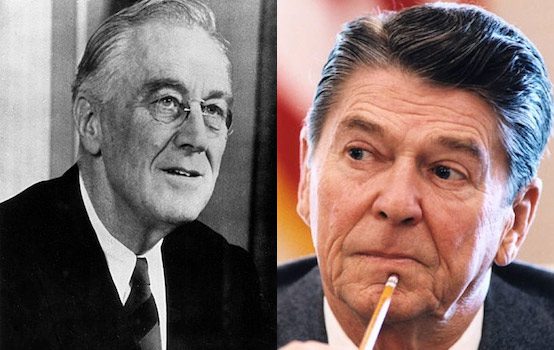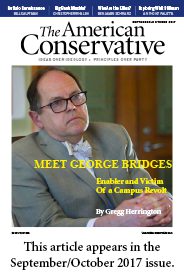Ronald Reagan Was Not an FDR Republican

When the historian David McCullough interviewed three of the living presidents, he found Gerald Ford and Jimmy Carter detached and uninterested. But the incumbent president, Ronald Reagan, was brimming with enthusiasm and extended the interview well past the allotted time. It is no secret that Ronald Reagan, who cast his first four presidential votes for FDR, remained an admirer of his predecessor throughout his public career. But does that mean—as Henry Olsen, my former colleague at the American Enterprise Institute and now at the Ethics and Public Policy Center, comes close to suggesting in The Working Class Republican—that Reagan was a New Deal conservative?
Not exactly, is my verdict. It was conventional wisdom in Washington when Reagan was elected president that he represented a reversal of all that Roosevelt stood for. That was partisan delusion. Both the 32nd and 40th presidents were broadly favorable toward free trade and mass immigration, though not without some caveats and tactical steps in the other direction. And both conducted a foreign policy of what Olsen felicitously terms “muscular defense of freedom’’—Roosevelt from about 1938 on and Reagan throughout his two terms. These are not small issues, and on each of them Donald Trump, who Olsen sees as another working-class Republican, stands in rhetoric and, to an extent yet undetermined, in practice, on the opposite side.
How much Reagan diverged from Roosevelt depends critically on what policies Roosevelt supported—and FDR often was purposely ambiguous about his actual views on numerous policies. You can quote Roosevelt, as Olsen does, for the proposition that welfare should not become a permanent dole, for example, while noting, as he also does, that FDR enacted what became Aid to Families with Dependent Children, a major federal welfare program.
Olsen mentions only in passing Roosevelt’s 1944 State of the Union address outlining policies for the postwar nation: steeply graduated tax rates; government control of crop and food prices; continued controls on wages; federal government guarantees of jobs, education, clothing, housing, and medical care; and a national service law to prevent strikes and “make available for war production or for any other essential services every able-bodied adult in this nation.” That sounds much like the Labour program for postwar Britain and was echoed, in diluted form, by the platform Harry Truman ran on in 1948 but failed to get through Congress afterward.
Reagan campaigned for Truman enthusiastically that year and, informed by his experience with thuggish communists in the union movement, opposed the left-wing Progressive candidacy of Henry Wallace, whose platform resembled Roosevelt’s 1944 proposals. Olsen repeatedly notes Reagan’s opposition to Wallace’s views without noting how close they were to at least some of Roosevelt’s. One suspects that Reagan, given his idolatry of Roosevelt, didn’t focus particularly on the similarity during this period.
And it’s fair to argue that Reagan’s endorsement of Dwight Eisenhower in 1952 was not necessarily a repudiation of Roosevelt either, given many Democrats’ push to embrace Ike as one of their own and the general’s refusal on the campaign trail and in office to countenance repeal of major New Deal legislation. That made Eisenhower anathema to Barry Goldwater and the young William F. Buckley Jr., but not to Reagan, who struck up a friendly mentee/mentor relationship with the post-presidential Eisenhower, as documented by Seattle physician Gene Kopelson in his Reagan’s 1968 Dress Rehearsal: Ike, RFK, and Reagan’s Emergence as a World Statesman.
The secrecy of his 1960s relationship with Eisenhower—no one before Kopelson unearthed it—fortifies my suspicion that Reagan was more ambitious than he wanted to appear, and that his ambition propelled his maneuvering to deliver his October 27, 1964, television speech on behalf of Barry Goldwater’s hapless candidacy. But, as Olsen shrewdly notes, he mentioned Goldwater only three-quarters of the way through; this was Reagan’s speech, a version of which he had been delivering on the mashed-potato circuit for General Electric, and it effectively elbowed Goldwater aside as conservative leader and made Reagan a national political figure.
Olsen describes in detail the difference between the two Republicans’ conservatism: Goldwater’s was theoretical, focused on freeing up Randian entrepreneurs, dedicated to repealing the New Deal; Reagan’s was practical, focused on empowering ordinary people to make their own choices, accepting the New Deal (with modifications), and opposing the growing power of the state as advocated by Henry Wallace and in Roosevelt’s 1944 State of the Union speech. Goldwater’s approach was suited to a man who had neither presidential ambition nor a temperamental inclination to the hard work of negotiation and compromise. Reagan, in my view and Olsen’s, had both the ambition and the temperament.
Olsen’s account of Reagan’s governorship of the nation’s largest state, his dogged pursuit of the presidency, and his eight years as president makes the point that he was practical, willing to take a step or two backward in hopes of taking three forward, willing to postpone some goals awaiting more propitious circumstances. In this, he resembled Margaret Thatcher as portrayed in the first two volumes of Charles Moore’s splendid authorized biography.
But I think Olsen overstates his case, or plunges it into the realm of cliche, when he writes that “he always acted on principles, but was never an ideologue.” Franklin Roosevelt seemed to assume that centralized government, staffed by managerial elitists, could provide to ordinary people the support they needed in a time when capitalist economic growth was a thing of the past. Ronald Reagan seemed to assume, as Olsen argues, that such a government gave too much power to bureaucrats and needed to be restrained in order to allow ordinary people to seek happiness and produce prosperity in their own way.
Olsen’s concluding chapters look at post-Reagan politics and, just a bit, at Donald Trump. He excoriates Republicans for concentrating on tax rates on high earners and for proposals to reshape entitlement programs such as Social Security and Medicare. He notes, as many others have, that Donald Trump won votes from white non-college-graduates who had spurned the party’s presidential candidates from 1992 to 2012. Olsen links this to Reagan’s success in winning over erstwhile Democrats in modest-income Los Angeles suburbs such as Norwalk and Lakewood in his 1966 and 1970 gubernatorial campaigns.
That point can be taken too far, however. The Reagan coalitions of 1980, 1984, and (with his vice president, George Bush, running) 1988 were tilted toward high-income voters, like the Republican coalitions of the preceding half-century. Thus in the critical state of Pennsylvania, Reagan and Bush carried metro Philadelphia with big margins from its affluent suburbs, but ran far behind Democrats, even in 1984, in more blue-collar metro Pittsburgh. Since Reagan left public view, those affluent suburbs in the north and, in 2016, even in Georgia, Texas, and Arizona, have moved toward Democrats on cultural issues; Republicans have lost the presidential popular vote in six of seven elections because their gains among white, non-college voters have not offset these losses and because immigrants have leaned Democratic. Reagan in 1984 won 59 percent of the popular vote and Bush in 1988 won 53 percent. No candidate of either party has won so high a percentage since.
And probably none will any time soon. One thing Franklin Roosevelt and Ronald Reagan had in common, beyond belief in free trade, immigration, and a muscular foreign policy, was a sympathy with and a mastery of the universal media of their times—radio, movies, and television (the latter of which FDR would have seen if he had lived as long as Reagan). Each of these media reached every corner of America and aspired to appeal to everyone. To get an idea of their reach, in 1930, a year when America had 123 million people, average movie attendance was 90 million weekly. As a boy Ronald Reagan could listen to Clear Channel radio stations in Chicago, the creative innovators of the day, broadcasting 100 miles west to Dixon, just as he listened to Franklin Roosevelt’s fireside chats in Iowa and California.
These universal media created a popular culture of high quality, and one that celebrated the goodness and decency and earned success of ordinary Americans. At their best, 1920s and 1930s radio programs, 1930s and 1940s movies, and 1950s and 1960s television presented an image of American-ness that still resonates today. Franklin Roosevelt, despite his aristocratic background, could speak in this language. For Ronald Reagan, who made his pre-political career in radio, movies, and television, it came instinctively and from the heart.
This universal media fostered a cultural uniformity, and so did the shared experiences of economic depression and world war—as did also the shared experience of unexpected postwar prosperity. This spirit was especially strong in the G.I. generation, those born starting around the same year as Reagan, who as adolescents lived through the economic doldrums of the 1930s and as young adults served in the armed forces in the 1940s and into the 1950s as well. This was the generation of which Reagan was the tribune, and of no one more than the midwesterners who had flocked to sunny California during and after the war and made it the largest state in America. They supported Democrat Pat Brown, who spent vast sums on water projects, highways, and colleges, against nationally prominent Republicans William Knowland and Richard Nixon. But when the intended beneficiaries of liberal policies rioted, in Berkeley in 1964 and Watts in 1965, they bridled. Enter Ronald Reagan, speaking the language of universal popular media, upholding traditional values and celebrating the ordinary citizen, and he was elected and reelected governor with 58 and 53 percent of the vote.
Nationally, voters who remembered the depression and the war rewarded presidents of both parties who appeared to produce peace and prosperity with landslide reelection victories in 1956, 1964, 1972, and 1984. (One could include FDR’s 1936 landslide, based on voter perceptions that he was restoring prosperity after years of depression.) But even as Reagan won that last landslide, the universal popular culture was in terminal decline, replaced by niche cultures appealing to Americans of various descriptions and demographics. Television and the movies, Reagan took the trouble to lament in his farewell speech in January 1989, were no longer “patriotic,” no longer spoke in that universal American language that once appealed to just about everyone.
Voters have been divided increasingly ever since along cultural and religious lines, and voters with no living memory of the Great Depression or the Second World War are no longer willing to cross partisan lines—for that would be a betrayal of values they hold most dear—to reward a president or party for apparent peace and prosperity. In only three of the last seven presidential elections have the nominees of either party received more than 50 percent of the vote, as nominees of one party or the other did in 12 of the 15 presidential elections from 1932 to 1988. Henry Olsen has shown how Ronald Reagan succeeded—but not how anyone can do it again.
Michael Barone, senior political analyst for the Washington Examiner and resident fellow at American Enterprise Institute, is the longtime co-author of The Almanac of American Politics and author of Our Country: The Shaping of America from Roosevelt to Reagan (1990).